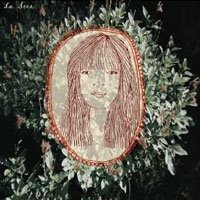
La Sera
La Sera
(Hardly Art; 2011)
By Lindsay Zoladz | 17 February 2011
Before we go ahead and declare La Sera’s self-titled debut one of the best albums to come out of this whole indie pop revival, we must first ask ourselves an important question: Why, exactly, does Best Coast suck? In the past year, Bethany Cosentino has been the most visible indie pop ambassador to such territories as NPR, Late Night with Jimmy Fallon, and your friendly neighborhood mainstream music critic’s top 10 list, and as a result there are a lot of people who naively believe that the entire genre’s peak is confoundingly well-regarded Crazy For You (2010), which to my ears just sounded like a subpar Rilo Kiley album on which Jenny Lewis is too stoned to reach for a rhyming dictionary.
On paper, Crazy For You seemed almost tailor-made for someone like me. I’m a sucker for simplicity, Amelia Fletcher, very nearly any song that employs the “Be My Baby” drumbeat, and I firmly believe in my heart of hearts that Beat Happening is a better band than Rush. And yet, over the past few years I’ve been disappointed by nearly every album (from bands like Dum Dum Girls and Frankie Rose & the Outs) that seeks to pay overt homage to all these elements.
It’s hard to pinpoint exactly why. Best Coast, the worst and most popular of these revivalists, are refreshing to me simply because it’s so easy to see why they suck. It’s not the flagrant amateurism; I say this because “Ask Me,” Heather Lewis’s warbling a cappella number on Jamboree (1988) still has the power to stop my heart in its tracks. No, it’s the stifling, stupefying sense of comfort that Crazy For You so proudly exudes. There isn’t the slightest tinge of conflict haunting the margins of these songs, no questions that hover unanswered (“Aren’t you gonna ask me what I did today?”), no hint of longings deeper or phrasings more imaginative than “I wish he was my boyfriend / I wish he was my boyfriend.” Crazy For You is oppressively flat: a brightly colored, one-dimensional picture book of pop, and spotlit in the center of each composition a paper doll of a punk rock girl.
Compared to Crazy For You, La Sera is a record of lush, muddy depth. Not that the lyrics are particularly deep (though they’re miles beyond “I wish my cat could talk”) but the difference here is that they are not meant to be the centerpieces of the songs. La Sera exudes an irresistibly dreamy atmosphere; it’s like a Black Tambourine album draped in satin. From the first swooning breaths of opener “Beating Heart,” the record exudes a haunting, almost pre-Raphaelite prettiness. It’s an ardent homage to 1960s pop and distortion pedals that never once feels studied or forced. In short, it’s the record for which we indie pop curmudgeons have been waiting for quite some time.
Goodman also sings and plays bass in Vivian Girls; that’s her ethereal voice cooing beneath lead singer Cassie Ramone’s Valley Girl snarl. La Sera sounds very much like a band lead by a background singer, but I mean that as a compliment. The vocals are gorgeous but diffuse, and thus devoid of that overbearing sense of attitude that Ramone and Contsantino are always a bit too eager to display; Goodman’s vocals aren’t the crisp focal points of the songs so much as another glistening element in the compositions. In comparing La Sera to the Babies, Ramone’s rather one-note side project between Vivian Girls albums, let’s just say point: Goodman.
La Sera mixes up distorted guitars (“Never Come Around,” “Been Here Before”) with pedal steel (“Devil’s Hearts Grow Gold,” “Under the Trees”) for a sound that is, on occasion, surprisingly twangy. Now that I know who Lady Antebellum is, I can confidently say that if they covered the Shangri-Las it would sound a lot like “Under the Trees,” except likely much worse. All of the competing elements of La Sera’s sound—the fuzzed-out pop, the folksy twang, and the lilting vocals—collide in perfect harmony on “Hold.” On this and a few of the record’s other standout moments, there’s a diffuse quality in Goodman’s voice that’s vaguely reminiscent of Kim Deal singing in angelic falsetto. By not trying so hard to fit the audacious frontwoman mold, Goodman proves to be a much more intriguing singer than most of her recent indie pop contemporaries. I wouldn’t exactly say that she’s got pipes, but just because you’re not going to sing “No Aloha” at an American Idol audition doesn’t mean it’s not an awesome song; I would extend the same praise to “Hold.”
If I might swing the conversation back to Best Coast for a moment, there’s another reason why I wasn’t interested in Crazy For You last year: I was too busy listening to Dolly Mixture’s Demonstration Tapes (1983), which was re-released as a part of the compilation Everything and More during the Summer of Cosentino. There was something about the timeliness of these two releases that bespoke how ostentatiously retrograde Crazy For You and its ilk actually sound. Now that its re-release has given us the choice, reaching for Crazy For You instead of Demonstration Tapes is a bit like favoring Johnny Depp as Willy Wonka rather than Gene Wilder. Half a year later, I’ll admit that I’m still under the spell of Demonstration Tapes and the unfulfilled promises of its successors, and I’ll continue to harbor impossibly high hopes for an indie pop band to play around with its own structural limitations and the traditional gender dynamics of 1960s pop—and to do it with half the energy and wit that Dolly Mixture did. La Sera aren’t quite up for that challenge, but their debut finds them rising above the careful posturing of their peers and creating something inarguably lovely, which, for now, will do.





